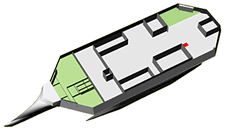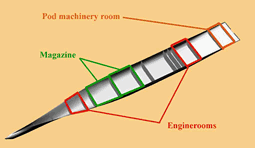|
Executive Summary
 The SEA FORCE ship was designed as one of a series of solutions to capabilities gaps identified in a larger study of Expeditionary Warfare. That study examined the forceful insertion of a USMC Expeditionary Brigade (MEB), using Ship To Objective Maneuver doctrine, to objectives as far as 200 nautical miles inland, with all support coming directly from the ships of the Sea Base - as far as 200 nautical miles offshore. Capability gaps identified in that study included: the need for increased logistical throughput by the ships of the Sea Base, including significantly greater aviation transport interfaces; and the need for a Heavy Lift Aircraft capable of lifting all USMC vehicles except the M1A1 tank and the Advanced Amphibious Assault Vehicle (AAAV). In addition, the study concluded that the need to transfer USMC cargo from ships of the Maritime Preposition Force or from re-supply ships to the amphibious ships of the Sea Base for further transfer ashore made the entire logistical supply operation too vulnerable. As a result the SEA FORCE ship was required to possess a much greater logistic throughput capability than planned ships; a much larger aviation support and interface capability; and the ability for all ships of the force to interface with transport-to-shore assets, such as aircraft, LCACs, LCUs and others. The SEA FORCE ship was designed as one of a series of solutions to capabilities gaps identified in a larger study of Expeditionary Warfare. That study examined the forceful insertion of a USMC Expeditionary Brigade (MEB), using Ship To Objective Maneuver doctrine, to objectives as far as 200 nautical miles inland, with all support coming directly from the ships of the Sea Base - as far as 200 nautical miles offshore. Capability gaps identified in that study included: the need for increased logistical throughput by the ships of the Sea Base, including significantly greater aviation transport interfaces; and the need for a Heavy Lift Aircraft capable of lifting all USMC vehicles except the M1A1 tank and the Advanced Amphibious Assault Vehicle (AAAV). In addition, the study concluded that the need to transfer USMC cargo from ships of the Maritime Preposition Force or from re-supply ships to the amphibious ships of the Sea Base for further transfer ashore made the entire logistical supply operation too vulnerable. As a result the SEA FORCE ship was required to possess a much greater logistic throughput capability than planned ships; a much larger aviation support and interface capability; and the ability for all ships of the force to interface with transport-to-shore assets, such as aircraft, LCACs, LCUs and others.
 The chosen solution was a class of ships which could be built in several variants of differing military/commercial characteristics. Some would have a high level of military characteristics, such as combat systems, damage control and survivability features; some would possess these traits to lesser degrees and be more nearly optimized for cargo and vehicle carrying. But all variants of the ship would have the ability to mate with the vehicles transporting cargo to the objective ashore. The envisioned concept was that the more military ships would play the LHA role during the early stages of the operation; as their sustainment stores are drawn down, re-supply or MPF ships, arriving with needed cargo, could "relieve" the LHA variants in the now more benign environment, permitting the LHA variant to return for additional sustainment supplies and enter into the re-supply mode. The three variants of the basic ship (LHA, MPF and Large Medium Speed Roll-on/Roll-off or LMSR re-supply) would be capable of doing any of the three missions credibly, though best designed for one of them. As the forcible entry operation evolves in nature, later arriving ships can assume the primary sustainment role since all are capable of full interface with the transport-to-shore systems. The chosen solution was a class of ships which could be built in several variants of differing military/commercial characteristics. Some would have a high level of military characteristics, such as combat systems, damage control and survivability features; some would possess these traits to lesser degrees and be more nearly optimized for cargo and vehicle carrying. But all variants of the ship would have the ability to mate with the vehicles transporting cargo to the objective ashore. The envisioned concept was that the more military ships would play the LHA role during the early stages of the operation; as their sustainment stores are drawn down, re-supply or MPF ships, arriving with needed cargo, could "relieve" the LHA variants in the now more benign environment, permitting the LHA variant to return for additional sustainment supplies and enter into the re-supply mode. The three variants of the basic ship (LHA, MPF and Large Medium Speed Roll-on/Roll-off or LMSR re-supply) would be capable of doing any of the three missions credibly, though best designed for one of them. As the forcible entry operation evolves in nature, later arriving ships can assume the primary sustainment role since all are capable of full interface with the transport-to-shore systems.
This set of characteristics, combined with the design team's desire to keep the required number of ships to support a MEB relatively small, resulted in a design which would require six ships to carry all the sustainment needed by the MEB. Other studies had shown a significant value to high transit speed which drove the design to a long, slender hull - and in order to restore the stability sacrificed by such a hull, the students opted for a trimaran design, whose outer hulls would ensure adequate stability without detracting significantly from speed. The trimaran has the synergistic property of inherently providing the large flight deck needed for the enhanced aviation tempo and Heavy Lift Aircraft mentioned above.
More Information
The following documents are available for download.
- Final Report
The final student report (DOC file). The same file in PDF is located here.
- Project Presentation:
- View Presentation (separate browser window).
Synchronized audio/video/slides. Requires MS Internet Explorer 5.0 or higher with Windows Media Player 6.4 or higher. High speed (DSL/LAN) internet connection is also needed.
- Download Presentation (PPT file). The same file in PDF is located here.
- Right-click to download Rhino-3D drawings:
- Student Brief (Windows Media):
Choose this if you are unable to view the project presentation. Choose according to your connection: [Dial-up] [LAN]
- CD Image Files - These are the final files from the yearly project CD and contain information in addition to what is available in these web pages.
- CD Image
ISO file, 693 MB. Right-click to download to your hard drive and then use your CD burning software to burn a copy of the entire CD.
- CD cover
PPT file.
- CD disc cover
DOC file.
|